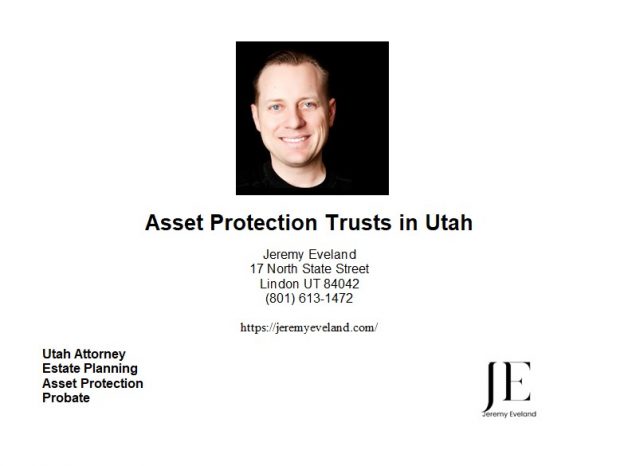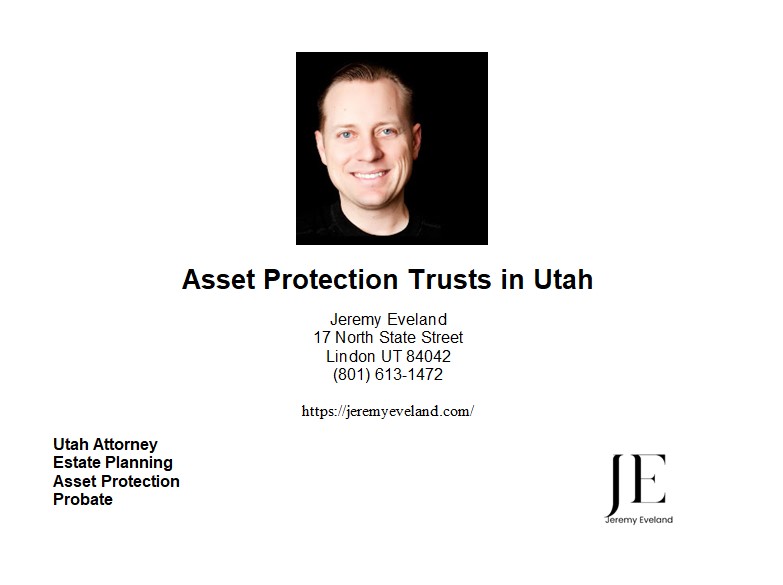Asset Protection Trusts in Utah: A Comprehensive Guide
In an era where financial security and asset preservation are paramount, Asset Protection Trusts (APTs) emerge as a strategic legal tool for individuals seeking to safeguard their wealth against potential creditors, lawsuits, and other claims. Utah recognizes the significance of such trusts and has established specific statutes to facilitate their creation and functionality. This comprehensive guide delves into the intricacies of Asset Protection Trusts in Utah, incorporating relevant code sections to provide a clear and authoritative overview.
Table of Contents
- Understanding Asset Protection Trusts
- Key Definitions
- Establishing an Asset Protection Trust in Utah
- Utah Code 75B-1-301: Definitions for Asset Protection Trusts
- Utah Code 75B-1-302: Asset Protection Trust Provisions
- Benefits of Asset Protection Trusts
- Limitations and Considerations
- Retirement Trusts as Asset Protection Vehicles
- Legal Implications and Enforcement
- Conclusion
Understanding Asset Protection Trusts
An Asset Protection Trust (APT) is a specialized legal arrangement designed to shield an individual's assets from creditors and legal judgments. By transferring ownership of assets to the trust, the settlor (the person creating the trust) relinquishes direct control, thereby offering protection against claims while still potentially benefiting from the trust's assets.
Utah's legal framework for APTs is outlined in Title 75B, Chapter 1, which governs trusts within the state. Specifically, Utah Code 75B-1-301 provides critical definitions, while Utah Code 75B-1-302 delineates the provisions for establishing and maintaining an Asset Protection Trust.
Key Definitions
To comprehend the functionality and requirements of Asset Protection Trusts in Utah, it's essential to understand the key terms as defined under Utah law:
- Settlor: A person who transfers property into a trust.
- Trustee: An individual or entity responsible for managing the trust assets in accordance with the trust's terms.
- Creditor: An individual or entity to whom the settlor owes a debt.
- Retirement Trust: A trust created primarily for the benefit of an employee or the employee's family, exempted from rules against perpetuities.
- Domestic Support Obligation: Includes child support, spousal support, and unsatisfied claims arising from property division in divorce proceedings.
- Insolvent: Incapable of paying debts as they become due or having a financial condition impaired significantly.
These definitions, detailed in Utah Code 75B-1-301, frame the legal context within which Asset Protection Trusts operate in Utah.
Establishing an Asset Protection Trust in Utah
Creating an Asset Protection Trust in Utah involves several steps, each designed to ensure that the trust meets the state's legal standards and effectively protects the settlor's assets. The process typically includes:
- Consultation with Legal Counsel: Given the complexity of trust law, it's advisable to engage with an attorney specializing in estate planning and asset protection.
- Drafting the Trust Instrument: The trust deed must clearly specify the terms, beneficiaries, and the trustee's powers and responsibilities.
- Funding the Trust: Transferring assets into the trust is a critical step. The assets can include real estate, investments, business interests, and other valuable properties.
- Compliance with Utah Law: Ensuring that the trust adheres to Utah's specific requirements, as outlined in Utah Code 75B-1-302, is paramount for its validity and effectiveness.
Utah Code 75B-1-301: Definitions for Asset Protection Trusts
Utah Code 75B-1-301 provides comprehensive definitions essential for understanding and establishing Asset Protection Trusts in Utah. Key definitions include:
-
Creditor:
- (a) A creditor or other claimant of the settlor existing when the trust is created.
- (b) A person who subsequently becomes a creditor, including various states of claims (e.g., secured, unsecured, legal, equitable).
- (c) Defines "Insolvent" and outlines conditions under which certain actions are not considered transfers to the trust.
-
Domestic Support Obligation:
- (a) Child support judgments or orders.
- (b) Spousal support judgments or orders.
- (c) Unsatisfied claims from property division in divorce proceedings.
-
Trust:
- Defined as per Section 75-1-201, encompassing real property, personal property, and interests therein.
These definitions are pivotal in determining eligibility and structuring the trust to comply with Utah's stringent asset protection standards.
Utah Code 75B-1-302: Asset Protection Trust Provisions
Utah Code 75B-1-302 delineates the specific provisions required for a trust to qualify as an Asset Protection Trust in Utah:
-
Creditor Limitations:
- Subsection (1): Establishes that if the settlor of an irrevocable trust is also a beneficiary, creditors cannot satisfy claims from the settlor's transfer to the trust or their beneficial interest.
-
Mandatory Provisions:
- Subsection (f)(i & ii): Prevents the settlor from voluntarily or involuntarily transferring their interest or requiring distributions to satisfy creditor claims.
- Subsection (g): Restricts the settlor's ability to amend, revoke, or terminate the trust without consent from beneficiaries with substantial interests.
-
Notification Requirements:
- Subsection (5)(g): Mandates that trustees notify individuals with domestic support obligations at least 30 days before any distribution to the settlor, ensuring transparency and accountability.
-
Affidavit of Intent:
- Subsection (3)(nn): Requires the settlor to sign a sworn affidavit affirming their authority to transfer assets, the non-insolvency of such transfers, and the absence of fraudulent intent.
-
Asset Restrictions:
- Prevents assets derived from unlawful activities from being transferred to the trust.
-
Enforceability:
- Trust provisions must be enforceable under applicable nonbankruptcy laws, ensuring that the trust's protective measures withstand legal scrutiny.
Failure to comply with these provisions, as outlined in Subsection (4), results in the trust's assets forfeiting the protections intended under Subsection (1).
Benefits of Asset Protection Trusts
Establishing an Asset Protection Trust in Utah offers several advantages:
- Creditor Protection: Shielding assets from creditors, ensuring that personal or business liabilities do not jeopardize the settlor's wealth.
- Estate Planning: Facilitating the smooth transfer of assets to beneficiaries while minimizing estate taxes and avoiding probate.
- Privacy: Trusts offer a level of confidentiality not typically available through wills or other estate planning instruments.
- Control over Asset Distribution: Even though the settlor relinquishes control, the trust instrument can stipulate specific terms for asset distribution, ensuring alignment with the settlor's wishes.
Limitations and Considerations
While Asset Protection Trusts provide robust protection, they come with certain limitations:
- Timing of Asset Transfer: Assets transferred to the trust must not be subject to any claims before the establishment of the trust. Transferring assets after debts are incurred or lawsuits are initiated may be deemed fraudulent.
- Irrevocability: Once established, APTs cannot be easily altered or revoked, limiting flexibility for the settlor.
- Costs: Setting up and maintaining a trust can incur significant legal and administrative expenses.
- Legal Scrutiny: Courts may examine the intent behind asset transfers to ensure they are not designed to defraud creditors.
Retirement Trusts as Asset Protection Vehicles
Utah distinguishes between general Asset Protection Trusts and Retirement Trusts. Defined under Utah Code 75B-1-2-01, Retirement Trusts are designed specifically for individuals seeking to protect assets primarily accrued through employment benefits, such as pensions or profit-sharing plans.
Key Features of Retirement Trusts
- Purpose-Specific: Created by employers as part of various benefit plans for the employees or their families.
- Exemptions: Not subject to traditional rules against perpetuities, accumulations, or suspensions of the power of alienation, allowing them to exist in perpetuity or for the necessary duration to fulfill their intended purposes (Utah Code 75B-1-202).
- Flexible Distribution: Can be tailored to meet specific retirement or benefit plans, ensuring that distributions align with the trust's objectives.
Legal Implications and Enforcement
Asset Protection Trusts must comply with both state and federal laws to ensure their enforceability. Utah's legal framework mandates:
- Exclusive Jurisdiction: Utah courts hold exclusive jurisdiction over trust-related claims, ensuring consistency in legal interpretations (Utah Code 75B-1-9).
- Superseding Other Provisions: Utah's asset protection laws take precedence over conflicting provisions in other Utah statutes, reinforcing the trust's protective measures (Utah Code 75B-1-11).
- Extinguishment of Prior Rights: Rights or claims established before the trust's enactment remain unaffected, preventing retroactive protection of assets.
Creditors seeking to challenge the validity of an Asset Protection Trust must provide clear and convincing evidence that the trust was established with fraudulent intent or that the settlor retained excessive control, as outlined in Utah Code 75B-1-302(c).
Conclusion
Asset Protection Trusts in Utah offer a sophisticated tool for individuals seeking to safeguard their assets against unforeseen liabilities and legal challenges. By adhering to Utah's specific legal requirements, as detailed in Utah Codes 75B-1-301 and 75B-1-302, and understanding the benefits and limitations of such trusts, individuals can effectively protect their wealth for future generations. However, due to the complexity of trust laws and the stringent requirements for establishing valid Asset Protection Trusts, consulting with experienced legal professionals is essential to navigate the process successfully and ensure optimal protection.
If you need an asset protection lawyer in the states of Utah or Nevada. Contact attorney Jeremy Eveland who regularly does trust law and asset protection. (801) 613-1472.
Asset Protection Trust Consultation
When you need help from an Asset Protection Trust Lawyer in Utah, call Jeremy D. Eveland, MBA, JD (801) 613-1472 for a consultation.
Jeremy Eveland
17 North State Street
Lindon UT 84042
(801) 613-1472

